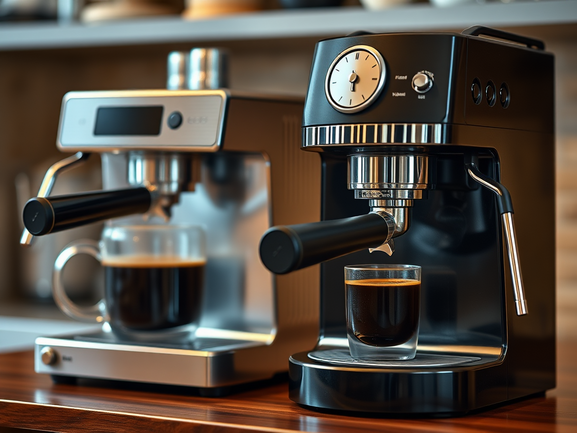Elevating Espresso: Why Water Quality Matters More Than You Think
There I was, bleary-eyed before dawn, cradling my favorite portafilter like a talisman—and it hit me: my espresso wasn’t the same. It tasted flat, almost lifeless, like someone had muted its vibrant spirit overnight. A single mineral speck in your water can transform a silky, head-turning crema into a dull, bitter disappointment that makes you question every step of your ritual. Water isn’t just an ingredient; it’s the unsung hero or villain backstage, deciding whether delicate chocolate, citrus, or berry notes dance on your tongue or get crushed under a torrent of chlorine and harsh salts.
Chlorine, excess calcium, magnesium—these culprits sneak into your cup, robbing your shot of clarity. Studies show that reverse osmosis water, followed by precise remineralization, removes up to 97% of total dissolved solids, then reintroduces the perfect balance of calcium and magnesium to amplify sweetness, brightness, and mouthfeel[5]. It’s like giving your espresso a finely tuned stage: no more background noise, just crisp, articulate flavors performing under perfect lighting.
Beyond taste, limescale is the silent assassin inside your machine. Mineral deposits accumulate invisibly in boilers, pipes, and heat exchangers, turning efficient pathways into clogged mazes. My machine used to groan—a merciful creak that eventually became groans of protest—until I swapped city water for RO-fed flows. Suddenly, pumps hummed smoothly, seals held tight, and maintenance calls nearly evaporated. Cafes report similar miracles: “We haven’t seen a scale issue in years,” one owner told me, grinning like a kid who’s just beaten a tough video game boss. Their secret weapon? A commercial RO system that forces water through a semipermeable membrane and multi-stage sediment pre-filters[4].
Sure, a simple carbon filter can rescind that telltale chlorine zing and reduce some scale build-up, but it’s a half-measure. Carbon leaves behind minerals that, over months, begin to gum up tiny crevices inside boilers and group heads. Even microscopic sulfates and chlorides—taste-robbing compounds—slip through, muting sweet floral highs and swirl of dark chocolate undertones[1]. In contrast, a full RO system with post-filters and a proper remineralization stage doesn’t just protect machinery; it builds a consistent flavor canvas no matter where you are or how fickle your water supply becomes. You don’t have to chase regional water chemistry or agonize over seasonal shifts in hardness—the repeating accuracy of your shots becomes almost poetic.
Imagine pouring a shot so pure, it’s like distilled sunshine. Every nuance is highlighted: that fleeting berry acidity, the velvet body, the lingering caramel kiss at the end. And it all starts with water no more complex than H2O, refined to its cleanest, then enriched with exactly the right minerals to let coffee sing. If you’re curious about the science behind this transformation and want to demystify how RO actually purifies and remyths water for coffee, dive into the guide on understanding reverse osmosis water filtration.
Inside the Machine: Pros And Cons Of Built-In Water Filters
Built-in filters feel like a lifesaver: they slot neatly into your machine, whisper away hard water’s worst offenders, and let you brew in confidence. With scale-inhibition technology trapping calcium and magnesium just enough to stop crusty deposits but not so aggressively that your espresso loses its vibrant zing, these filters extend the life of heat exchangers and group heads, trimming down those dreaded descaling sessions. A spotless boiler means faster heat recovery and, let’s be honest, a more reliable morning routine. But here’s the catch: even superheroes grow fatigued if you don’t change their capes on schedule.
In regions with screaming-hard water, built-in filters can become chokepoints—pretty fast. Once they clog beyond a critical threshold, water flow slows to a laborious drip, leaving you staring at a pitiful puddle where your shot should be. Sara from Daily Grind Café recounts a week of lost sales: “We cut our service calls in half when we first installed the on-board filter,” she said, relief in her voice. “But when it finally choked, shots crawled, and we had customers tapping their watches. That’s when I learned a filter’s a blessing only if you actually swap it out.” Regular swap schedules are non-negotiable goggles for guaranteed performance.
And while most built-ins excel at taming chlorine and some scale-causing minerals, they can’t rival a multi-stage reverse osmosis system for purging every last dissolved solid and contaminant. Trace sulfates or chlorides—harmless to health but tragic for taste—can slip by, dulling your brew’s brightness over months of steady use. If you’re weighing the trade-offs, the in-depth overview of reverse osmosis benefits highlights why serious baristas and high-volume cafes often opt for RO systems paired with post-filtration remineralization cartridges that deliver both machine protection and flavor consistency.
The bottom line? Built-in filters are a superb first line of defense—compact, convenient, and cost-effective. They require minimal setup and deliver immediate improvements in taste and machine health. But they demand vigilance: skip a replacement, and you’ll find yourself scrubbing scale, wrestling with slow extractions, and cursing the very convenience you once praised. Like any maintenance plan, success hinges on routine: set reminders, keep spares of the manufacturer’s recommended cartridges, and don’t let complacency creep in. With that, your machine’s heart will keep pacing with reliability and your espresso will continue to flow, unimpeded and full of life.
The RO Revolution: Pure Water’s Role in Espresso Excellence
Picture this: you pull a shot so clean, so transparent in its sweetness, it’s like tasting first light on a spring morning. That’s the promise of reverse osmosis in espresso—95–97% removal of unwanted minerals and impurities leaves only the purest water to flirt with your coffee grounds. The process is almost poetic: water, compelled by pressure, squeezes through a semipermeable membrane that halts particles as tiny as single atoms. No chlorine buzz, no metallic aftertaste—just coffee’s unmasked personality, performing at its finest[1].
Beyond flavor, limescale buildup is the enemy of every espresso machine’s longevity. Calcium and magnesium crystals, accumulating over weeks and months, stealthily coat boiler walls and heat exchangers, transforming a high-performance piece of art into a sluggish, high-maintenance chore. But with RO-prepped water, scale is virtually banished at the source. Baristas speak of machines that hum along for years, seductively whispering through thousands of shots with barely a hiccup. I’ve heard from a veteran who enjoyed fourteen years of frustration-free brewing simply by pairing RO and a humble remineralization cartridge recommended by machine makers[clive coffee]. That’s not just performance—that’s peace of mind.
Flavor-wise, the difference borders on magical. Crema becomes plush and persistent, holding its head high like a victory banner. Fruity or floral notes, once shy, leap forward with newfound confidence, dancing across taste buds in an elegant minuet. One café owner extolled the virtues of RO water to Perfect Daily Grind: switching felt like “rediscovering my espresso all over again,” praising consistency even as municipal water chemistry swung wildly with seasons[5]. It’s not just a single-cup upgrade; it’s a wholesale elevation of your coffee program.
Cost-conscious operators find that commercial RO setups—often around $1,690—rapidly pay for themselves. Fewer descaling visits mean reduced labor, lower maintenance bills, and machines that outperform year after year. High-volume shops investing in multi-stage RO units with pre- and post-filtration are guiding baristas on how to tailor remineralization for different coffee profiles, ensuring every espresso feels as fresh as opening day. The RO revolution isn’t hype; it’s a strategic upgrade for flavor fanatics and machine savers alike.
Dollars, Drops, and Downtime: Comparing Costs and Care
It’s tempting to weigh a $30 carbon filter replacement against a $1,690 RO system only by sticker price. But real-world calculus factors in machine health, shot consistency, and the human cost of emergency repairs in mid-service rushes. Yes, carbon filters slot in under $30, handle chlorine with ease, and shield heat exchangers from moderate scale buildup for a couple of months. You spend under $120 annually, breathe easy for a moment, and change the cartridge in a snap.
Reverse osmosis, on the other hand, demands more upfront commitment—a roughly $1,690 initial outlay for a robust commercial setup. Maintenance is more involved too: pre-filters every six months, membrane swaps yearly, and occasional system flushes for peak performance. But the dividends come in the form of near-zero scale damage, fewer surprise breakdowns, and machine warranties that stay intact thanks to manufacturer-approved upkeep schedules[4]. Rather than reactive fixes, you enjoy proactive confidence.
| Water Treatment Type | Upfront Cost | Annual Maintenance | Scale Protection | Flavor Consistency |
|---|---|---|---|---|
| Carbon-Based Filter | $20–$30 | $80–$120 | Moderate | Variable |
| Reverse Osmosis System | $1,690 | $150–$300 | Near Complete | High |
Bottom line: carbon filters are wallet-friendly and easy to swap, perfect for casual home baristas or cafés on a shoestring. RO systems, by contrast, shoulder a larger initial and upkeep load but clip the wings of scale, deliver bulletproof shot consistency, and often reduce repair costs by hundreds of dollars each year. Many cafes find that the routine rituals around RO maintenance become second nature—and that those minor downtimes are a bargain for uninterrupted performance.
Key Takeaways & Final Words
At this point, your choice should hinge on taste priorities, water hardness, budget constraints, and machine maker guidelines. If you crave unparalleled clarity and fear limescale more than routine maintenance, reverse osmosis with precise remineralization stands unrivaled—removing up to 97% of dissolved solids, virtually eliminating scale, and letting espresso’s personality shine[1]. For a full breakdown of shop-oriented installs, check out the piece on setting the perfect RO system for your coffee shop.
If you prefer a leaner investment and water supply qualifies as moderately hard, carbon-based filters preserve body-boosting minerals while keeping chlorine at bay, all for under $120 a year[culligan]. They won’t banish every trace of unwanted compounds, but they deliver a neat compromise of budget, taste, and equipment protection.
Commercial venues often blend the best of both worlds: multi-stage RO systems upfront paired with post-filtration remineralization, balancing shot clarity and maintenance ease. While the sticker shock—around $1,690—can sting initially, café owners report fewer breakdowns, prouder pours, and loyal customers returning for the purity of flavor that only RO can deliver[4]. And yes, I’ve found firsthand that when you match your local water report to these criteria and follow the steps in the comprehensive install guide, the decision becomes far less daunting—and far more rewarding.
- Clive Coffee – The Importance of Water and Your Espresso Machine
- Culligan – Tap Water Filter vs Reverse Osmosis Water
- Home-Barista.com – Regular Water Filter vs Reverse Osmosis
- OsmosisInfo – Setting Up the Perfect RO System for Your Coffee Shop: A Comprehensive Guide
- OsmosisInfo – Understanding Reverse Osmosis Water Filtration
- OsmosisInfo – Unlocking the Power of Reverse Osmosis: From Basics to Benefits
- Perfect Daily Grind – The Importance of Water Quality in Espresso
- Pro Aqua Water – Coffee Shops Need a Commercial Reverse Osmosis System

Dr. Tina M. Nenoff is a senior scientist and Sandia Fellow at Sandia National Laboratories, renowned for her pioneering work in nanoporous materials. Her research focuses on the chemistry of confinement and reactivity of ions and molecules within these materials, leading to significant advancements in environmental remediation and energy applications. Notably, she played a crucial role in developing crystalline silicotitanates used to remove radioactive cesium from contaminated seawater following the Fukushima Daiichi nuclear disaster.


